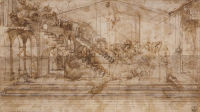Light and Vision Click on the thumbnails to explore the trail
Read more about this trail (expand)
According to Leonardo, the most important of the five senses was sight, the eye being the “window of the soul”. Leonardo thought a great deal about how the eye functioned and how we experience the world in terms of light and shade. His studies of the effects of light on form provided the basis for a revolution in the way that light, colour and space were described in painting.

- Enlarge
- Zoom & explore
- © Soprintendenza Speciale Polo Museale Fiorentino
Preparatory study for the background of the Adoration of the Magi 1481
In the 15th century, sight was thought to reach the eye in the form of a pyramid or cone that originates from the edges of objects and converges to meet in a point at the eye. On this basis, a system replicating the effects of vision was discovered that allowed artists to portray objects in three-dimensions within a credible spatial environment. This system, which we now call linear perspective, was discovered by the architect Brunelleschi and was based on geometry. As such, it was an artist’s best claim to intellectual fame.
In this study for the Adoration of the Magi, Leonardo has applied his knowledge of linear perspective to create a rational, geometrically constructed space within which to situate the narrative.
The perspective construction is incredibly laboured and Leonardo seems to go beyond the requirements of the drawing. However, it has allowed him to create the elaborate architectural structure on the left and to position figures and animals in space to create complex relationships. Although primarily an intellectual exercise, the detailed perspective scheme has provided Leonardo with the stimulus for fantasy and compositional invention.
In Leonardo's words
Painting is based upon perspective, which is nothing else than a thorough knowledge of the function of the eye. And this function simply consists in receiving in a pyramid the forms and colours of all the objects placed before it.
This meticulous perspective study relates to the architectural structure seen in the background of the Adoration of the Magi altarpiece, which Leonardo left unfinished before leaving for Milan sometime in 1481 or 1482.
The drawing develops the idea for an architectural structure as sketched in an early compositional drawing now in the Louvre. However, in this careful and complex drawing, Leonardo works towards achieving an asymmetrical balance that prevents the eye from focusing on a central vanishing point, by placing the point at which the orthogonals converge to the right of the centre.
The perspective construction of the tiled floor is amongst the most rigorous of all Renaissance demonstrations of the method proposed by Leon Battista Alberti for single point perspective construction in his treatise On Painting, which appeared in Florence in 1535. Despite the laborious nature of this study, it did not represent the definitive solution for Leonardo. A comparison with the background of the Adoration painting shows that not only were details altered, but the relative proportions of major elements were also substantially adjusted in the final solution.
- Medium Pen and ink over metalpointwith brown wash and traces of white heightening
- Size 16.3 x 29 cm
- Location Gabinetto dei Disegni e delle Stampe degli Uffizi












